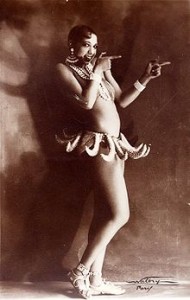Josephine Baker
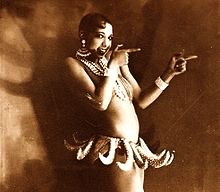
Chasing a Rainbow: The Life of Joséphine Baker
1986. Channel Four Films & Csaky Ltd., Narrated by Todd Olivier. Directed by Christopher Ralling., IDA Award & International Emmy Award for best documentary, 1987. I encourage everyone to watch this interview with Julie Menin where Jean-Claude Baker discusses Joséphine’s children (part 1).
Josephine Baker in her famous banana striptease costume.
Josephine Baker (June 3, 1906 – April 12, 1975) was an American-born French dancer, singer, and actress. Born Freda Josephine McDonald in St. Louis, Missouri, she became a citizen of France in 1937. Fluent in both English and French, Baker became an international musical and political icon. She was given such nicknames as the “Bronze Venus”, the “Black Pearl”, and the “Créole Goddess”.
Baker was the first African American female to star in a major motion picture, Zouzou, to integrate an American concert hall, and to become a world-famous entertainer. She is also noted for her contributions to the Civil Rights Movement in the United States (she was offered the unofficial leadership of the movement by Coretta Scott King in 1968 following Martin Luther King, Jr.‘s assassination, but turned it down), for assisting the French Resistance during World War II, and for being the first American-born woman to receive the French military honor, the Croix de guerre.
Early Life
Baker was born Freda Josephine McDonald in St. Louis, Missouri, the daughter of Carrie McDonald. Her estate identifies vaudeville drummer Eddie Carson as her natural father. A biography written by her foster son Jean-Claude Baker stated:
“… (Josephine Baker’s) father was identified (on the birth certificate) simply as “Edw” … I think Josephine’s father was white—so did Josephine, so did her family … people in St. Louis say that (Josephine’s mother) had worked for a German family (around the time she became pregnant). (Carrie) let people think Eddie Carson was the father, and Carson played along …” (but) Josephine knew better.
Her mother, Carrie, was adopted in Little Rock, Arkansas in 1886 by Richard and Elvira McDonald, both of whom were former slaves of African and Native American descent. When Baker was eight she was sent to work for a white woman who abused her, burning Baker’s hands when she put too much soap in the laundry. She later went to work for another woman.
 Baker dropped out of school at the age of 12 and lived as a street child in the slums of St. Louis, sleeping in cardboard shelters and scavenging for food in garbage cans. Her street-corner dancing attracted attention and she was recruited for the St. Louis Chorus vaudeville show at 15. She then headed to New York City during the Harlem Renaissance, performing at the Plantation Club and in the chorus of the popular Broadway revues Shuffle Along (1921) with Adelaide Hall and The Chocolate Dandies (1924). She performed as the last dancer in a chorus line, a position in which the dancer traditionally performed in a comic manner, as if she was unable to remember the dance, until the encore, at which point she would not only perform it correctly, but with additional complexity. Baker was then billed as “the highest-paid chorus girl in vaudeville.”
Baker dropped out of school at the age of 12 and lived as a street child in the slums of St. Louis, sleeping in cardboard shelters and scavenging for food in garbage cans. Her street-corner dancing attracted attention and she was recruited for the St. Louis Chorus vaudeville show at 15. She then headed to New York City during the Harlem Renaissance, performing at the Plantation Club and in the chorus of the popular Broadway revues Shuffle Along (1921) with Adelaide Hall and The Chocolate Dandies (1924). She performed as the last dancer in a chorus line, a position in which the dancer traditionally performed in a comic manner, as if she was unable to remember the dance, until the encore, at which point she would not only perform it correctly, but with additional complexity. Baker was then billed as “the highest-paid chorus girl in vaudeville.”
On October 2, 1925, she opened in Paris at the Théâtre des Champs-Élysées, where she became an instant success for her erotic dancing and for appearing practically nude on stage. After a successful tour of Europe, she reneged on her contract and returned to France to star at the Folies Bergères, setting the standard for her future acts. She performed the Danse sauvage, wearing a costume consisting of a skirt made of a string of artificial bananas. Her success coincided (1925) with the Exposition des Arts Décoratifs, which gave birth to the term “Art Deco“, and also with a renewal of interest in ethnic forms of art, including African. Baker represented one aspect of this fashion. In later shows in Paris she was often accompanied on stage by her pet cheetah, Chiquita, who was adorned with a diamond collar. The cheetah frequently escaped into the orchestra pit, where it terrorized the musicians, adding another element of excitement to the show.
Rise to fame
After a short while she was the most successful American entertainer working in France. Ernest Hemingway called her “… the most sensational woman anyone ever saw.” In addition to being a musical star, Baker also starred in three films which found success only in Europe: the silent film Siren of the Tropics (1927), Zouzou (1934) and Princesse Tam Tam (1935). She also starred in Fausse Alerte in 1940.
 Baker in a topless photo shoot.
Baker in a topless photo shoot.
At this time she also scored her most successful song, “J’ai deux amours” (1931) and became a muse for contemporary authors, painters, designers, and sculptors including Langston Hughes, Ernest Hemingway, F. Scott Fitzgerald, Pablo Picasso, and Christian Dior. Under the management of Giuseppe Pepito Abatino — a Sicilian former stonemason who passed himself off as a count — Baker’s stage and public persona, as well as her singing voice, were transformed.
In 1934 she took the lead in a revival of Jacques Offenbach‘s 1875 opera La créole at the Théâtre Marigny on the Champs-Élysées of Paris, which premiered in December of that year for a six month run. In preparation for her performances she went through months of training with a vocal coach. In the words of Shirley Bassey, who has cited Baker as her primary influence, “… she went from a ‘petite danseuse sauvage’ with a decent voice to ‘la grande diva magnifique’ … I swear in all my life I have never seen, and probably never shall see again, such a spectacular singer and performer.”
Despite her popularity in France, she never obtained the same reputation in America. Upon a visit to the United States in 1935-1936, her performances received poor opening reviews for her starring role in the Ziegfeld Follies and she was replaced by Gypsy Rose Lee later in the run.
Baker returned to Paris in 1937, married a Frenchman, Jean Lion, who was Jewish, and became a French citizen. They were married in the French city of Crévecoeur le Grand. The wedding was presided over by the mayor at the time, Jammy Schmidt. During the ceremony, when she was asked if she was ready to give up her American citizenship, it has been claimed that she renounced it without difficulty.
Her affection for France was so great that when World War II broke out, she volunteered to spy for her adopted country. Baker’s agent’s brother approached her about working for the French government as an “honorable correspondent”, if she happened to hear any gossip at parties that might be of use to her adopted country, she could report it. Baker immediately agreed, since she was against the Nazi stand on race, not only because she was black but because her husband was Jewish. Her café society fame enabled her to rub shoulders with those in-the-know, from high-ranking Japanese officials to Italian bureaucrats, and report back what she heard. She attended parties at the Italian embassy without any suspicion falling on her and gathered information. She helped in the war effort in other ways, such as by sending Christmas presents to French soldiers. When the Germans invaded France, Baker left Paris and went to the Château des Milandes, her home in the south of France, where she had Belgian refugees living with her and others who were eager to help the Free French effort led from England by Charles de Gaulle. As an entertainer, Baker had an excuse for moving around Europe, visiting neutral nations like Portugal, and returning to France. Baker assisted the French Resistance by smuggling secrets written in invisible ink on her sheet music.
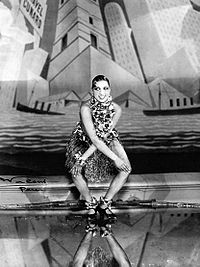 Josephine Baker dancing the Charleston, 1926
Josephine Baker dancing the Charleston, 1926
She helped mount a production in Marseille to give herself and her like-minded friends a reason for being there. She helped quite a lot of people who were in danger from the Nazis get visas and passports to leave France. Later in 1941, she and her entourage went to the French colonies in North Africa; the stated reason was Baker’s health (since she really was recovering from another case of pneumonia) but the real reason was to continue helping the Resistance. From a base in Morocco, she made tours of Spain and pinned notes with the information she gathered inside her underwear (counting on her celebrity to avoid a strip search) and made friends with the Pasha of Marrakesh, whose support helped her through a miscarriage (the last of several) and emergency hysterectomy she had to go through in 1942. After her recovery, she started touring to entertain Allied soldiers in North Africa. She even persuaded Egypt’s King Farouk to make a public appearance at one of her concerts, a subtle indication of which side his officially neutral country leaned toward. Later, she would perform at Buchenwald for the liberated inmates who were too frail to be moved.
After the war, for her underground activity, Baker received the Croix de guerre, the Rosette de la Résistance, and was made a Chevalier of the Légion d’honneur by General Charles de Gaulle.
In January 1966, she was invited by Fidel Castro to perform at the Teatro Musical de La Habana in Havana, Cuba. Her spectacular show in April of that year led to record breaking attendance. In 1968, Baker visited Yugoslavia and made appearances in Belgrade and in Skopje. In 1973, Baker opened at Carnegie Hall to a standing ovation. In 1974, she appeared in a Royal Variety Performance at the London Palladium.
Civil Rights Activism
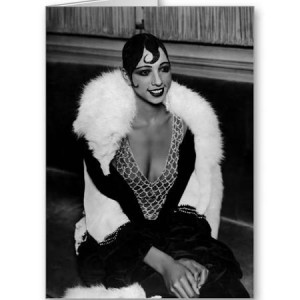 Although based in France, Baker supported the American Civil Rights Movement during the 1950’s. She protested in her own way against racism, adopting 12 multi-ethnic orphans, whom she called the “Rainbow Tribe.” In addition, she refused to perform for segregated audiences in the United States. Her insistence on mixed audiences helped to integrate shows in Las Vegas, Nevada.
Although based in France, Baker supported the American Civil Rights Movement during the 1950’s. She protested in her own way against racism, adopting 12 multi-ethnic orphans, whom she called the “Rainbow Tribe.” In addition, she refused to perform for segregated audiences in the United States. Her insistence on mixed audiences helped to integrate shows in Las Vegas, Nevada.
In 1951, Baker made charges of racism against Sherman Billingsley‘s Stork Club in Manhattan, where she alleged that she’d been refused service. Actress Grace Kelly, who was at the club at the time, rushed over to Baker, took her by the arm and stormed out with her entire party, vowing never to return (and she never did). The two women became close friends after the incident. Testament to this was made evident when Baker was near bankruptcy and was offered a villa and financial assistance by Kelly (who by then was princess consort of Rainier III of Monaco). (However, during his work on the Stork Club book, author and New York Times reporter Ralph Blumenthal was contacted by Jean-Claude Baker, one of Josephine Baker’s sons. Having read a Blumenthal-written story about Leonard Bernstein‘s FBI file, he indicated that he had read his mother’s FBI file and, using comparison of the file to the tapes, said he thought the Stork Club incident was overblown.)
Baker worked with the NAACP. In 1963, she spoke at the March on Washington at the side of Martin Luther King, Jr. Baker was the only official female speaker and while wearing her Free French uniform emblazoned with her medal of the Légion d’honneur she introduced the “Negro Women for Civil Rights.” Rosa Parks and Daisy Bates were among those she acknowledged and both gave brief speeches. After King’s assassination, his widow Coretta Scott King approached Baker in Holland to ask if she would take her husband’s place as leader of the American Civil Rights Movement. After many days of thinking it over, Baker declined, saying her children were “too young to lose their mother.”
Personal life
Baker had 12 children through adoption. She bore only one child herself, stillborn in 1941, an incident which precipitated an emergency hysterectomy. Baker raised two daughters, French-born Marianne and Moroccan-born Stellina, and ten sons, Korean-born Akio, Japanese-born Jeannot (or Janot), Colombian-born Luis, Finnish-born Jari, French-born Jean-Claude and Noël, Israeli-born Moïse, Algerian-born Brahim, Ivorian-born Koffi, and Venezuelan-born Mara. For some time, Baker lived with her children and an enormous staff in a castle, Château de Milandes, in Dordogne, France, with her fourth husband Jo Bouillon (a French conductor).
Baker pictured in her most famous costume for the Danse banane
Josephine Baker was married four times. Her first marriage was to pullman Willie Wells in 1918 when she was just 13, and which was reportedly a very unhappy marriage. It was short lived and they divorced a short time later. She married Willie Baker in 1921 but that marriage also was short lived. She retained that last name simply because her career began taking off during that time and that is the last name with which she became best known. In 1937 she married Frenchman Jean Lion, during which time she received French citizenship and became a permanent expatriate. She and Lion separated before he passed away. In 1947 she married French Composer Jo Bouillon. They also divorced. She was later involved for a time with artist Joe Brady, but they never married.
Baker was bisexual. Her son Jean-Claude Baker and co-author Chris Chase state in Josephine: The Hungry Heart that “she was involved in numerous lesbian affairs, both while she was single and married, and mention six of her female lovers by name. Clara Smith, Evelyn Sheppard, Bessie Allison, Ada “Bricktop” Smith, and Mildred Smallwood were all African-American women whom she met while touring on the black performing circuit early in her career.” She was also reportedly involved intimately with French writer Colette. Not mentioned, but confirmed since, was her affair with Mexican artist Frida Kahlo. Jean-Claude Baker, who interviewed over 2,000 people while writing his book, wrote that affairs with women were not uncommon for his mother throughout her lifetime. He was quoted in one interview as saying:
“She was what today you would call bisexual, and I will tell you why. Forget that I am her son, I am also a historian. You have to put her back into the context of the time in which she lived. In those days, Chorus Girls were abused by the white or black producers and by the leading men if he liked girls. But they could not sleep together because there were not enough hotels to accommodate black people. So they would all stay together, and the girls would develop lady lover friendships, do you understand my English? But wait wait…If one of the girls by preference was gay, she’d be called a bull dyke by the whole cast. So you see, discrimination is everywhere.”
Death
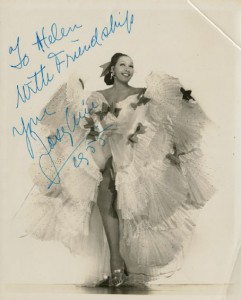 On April 8, 1975, Baker starred in a retrospective revue at the Bobino in Paris, Joséphine à Bobino 1975, celebrating her 50 years in show business. The revue, financed by Prince Rainier, Princess Grace, and Jacqueline Kennedy Onassis, opened to rave reviews. Demand for seating was such that fold-out chairs had to be added to accommodate spectators. The opening-night audience included Sophia Loren, Mick Jagger, Shirley Bassey, Diana Ross and Liza Minnelli.
On April 8, 1975, Baker starred in a retrospective revue at the Bobino in Paris, Joséphine à Bobino 1975, celebrating her 50 years in show business. The revue, financed by Prince Rainier, Princess Grace, and Jacqueline Kennedy Onassis, opened to rave reviews. Demand for seating was such that fold-out chairs had to be added to accommodate spectators. The opening-night audience included Sophia Loren, Mick Jagger, Shirley Bassey, Diana Ross and Liza Minnelli.
Four days later, Baker was found lying peacefully in her bed surrounded by newspapers with glowing reviews of her performance. She was in a coma after suffering a cerebral hemorrhage. She was taken to Pitié-Salpêtrière Hospital, where she died, aged 68, on April 12, 1975. Her funeral was held at L’Église de la Madeleine. The first American woman to receive full French military honors at her funeral, Baker locked up the streets of Paris one last time. She was interred at the Cimetière de Monaco in Monte Carlo.

